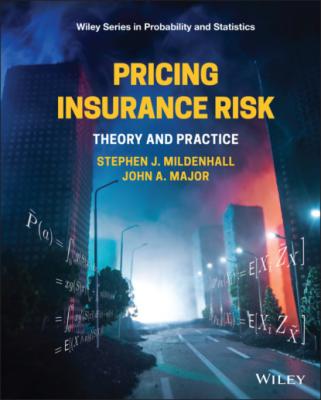Pricing Insurance Risk. Stephen J. Mildenhall
Читать онлайн.| Название | Pricing Insurance Risk |
|---|---|
| Автор произведения | Stephen J. Mildenhall |
| Жанр | Банковское дело |
| Серия | |
| Издательство | Банковское дело |
| Год выпуска | 0 |
| isbn | 9781119756521 |
10 Part III Price Allocation12 Classical Price Allocation Theory12.1 The Allocation of Portfolio Constant CoC Pricing12.2 Allocation of Non-Additive Functionals12.3 Loss Payments in Default12.4 The Historical Development of Insurance Pricing Models12.5 Learning Objectives13 Classical Price Allocation Practice13.1 Allocated CCoC Pricing13.2 Allocation of Classical PCP Pricing13.3 Learning Objectives14 Modern Price Allocation Theory14.1 The Natural Allocation of a Coherent Risk Measure14.2 Computing the Natural Allocations14.3 A Closer Look at Unit Funding14.4 An Axiomatic Approach to Allocation14.5 Axiomatic Characterizations of Allocations14.6 Learning Objectives15 Modern Price Allocation Practice15.1 Applying the Natural Allocations to Discrete Random Variables15.2 Unit Funding Analysis15.3 Bodoff’s Percentile Layer of Capital Method15.4 Case Study Exhibits15.5 Learning Objectives
11 Part IV Advanced Topics16 Asset Risk16.1 Background16.2 Adding Asset Risk to Ins Co.16.3 Learning Objectives17 Reserves17.1 Time Periods and Notation17.2 Liability for Ultimate Losses17.3 The Solvency II Risk Margin17.4 Learning Objectives18 Going Concern Franchise Value18.1 Optimal Dividends18.2 The Firm Life Annuity18.3 Learning Objectives19 Reinsurance Optimization19.1 Background19.2 Evaluating Ceded Reinsurance19.3 Learning Objectives20 Portfolio Optimization20.1 Strategic Framework20.2 Market Regulation20.3 Dynamic Capital Allocation and Marginal Cost20.4 Marginal Cost and Marginal Revenue20.5 Performance Management and Regulatory Rigidities20.6 Practical Implications20.7 Learning Objectives
12 A Background MaterialA.1 Interest Rate, Discount Rate, and Discount FactorA.2 Actuarial vs. Accounting Sign ConventionsA.3 Probability TheoryA.4 Additional Mathematical Terminology
13 B Notation
14 References
15 Index
List of Figures
1 Chapter 1Figure 1.1 Players and their roles. The regulator...Figure 1.2 The different roles of capital and pricing risk measures.
2 Chapter 2Figure 2.1 The eight variables that control...Figure 2.2 Tame Case Study, gross (top...Figure 2.3 Tame Case Study, bivariate densities:...Figure 2.4 Cat/Non-Cat Case Study, gross...Figure 2.5 Cat/Non-Cat Case Study, bivariate...Figure 2.6 Hu/SCS Case Study, gross (top)...Figure 2.7 Hu/SCS Case Study, bivariate densities...
3 Chapter 3Figure 3.1 Taxonomy of insurance-related risk.Figure 3.2 The original Lee diagram. Source...Figure 3.3 Different ways of computing...Figure 3.4 The random variables, distribution...Figure 3.5 Random variables, functions of an explicit state.Figure 3.6 Survival functions of the outcome.Figure 3.7 Lee diagrams, function of a dual...Figure 3.8 Different ways of computing the...Figure 3.9 Sample layering functions for Exercise 26.Figure 3.10 Insurance variables in a Lee diagram.Figure 3.11 Two ways of computing expected loss from a discrete sample.Figure 3.12 Accounting for the effect of adding 1 to each outcome.Figure 3.13 Lee diagram showing relationship between...Figure 3.14 Potential functional forms for risk...
4 Chapter 4Figure 4.1 The two ways a distribution...Figure 4.2 Three types of discontinuous behavior...Figure 4.3 Five independent Bernoulli random...Figure 4.4 Quantile function for the outcomes...Figure 4.5 Left: the distribution function F corresponding...Figure 4.6 Left: the interpolated distribution function...Figure 4.7 Crossed (darker) and uncrossed or...Figure 4.8 Left: TVaR (solid) and quantile...Figure 4.9 Discrete example, TVaR, and VaR...Figure 4.10 Tame Case Study, TVaR, and VaR...Figure 4.11 Cat/Non-Cat Case Study, TVaR,...Figure 4.12 Hu/SCS Case Study, TVaR, and...Figure 4.13 Left: the graph of...Figure 4.14 TVaR, CTE, and quantile functions for X.Figure 4.15 VaR and TVaR as solutions to an...
5 Chapter 5Figure 5.1 The basic structure of Ins...Figure 5.2 Relationships between properties...Figure 5.3 The graph of...Figure 5.4 Acceptance sets and corresponding...Figure 5.5 The distribution (left) and...Figure 5.6 The impact of...Figure 5.7 A typical real valued convex...Figure 5.8 Cherny’s generator set for...Figure 5.9 Different modes of convergence for random variables.
6 Chapter 8Figure 8.1 Services provided by an insurance...Figure 8.2 Interactions between the product and...Figure 8.3 A simple (left) and realistic capital structure (right).Figure 8.4 Capital, surplus, and equity under market value...Figure 8.5 Market value and accounting value balance...Figure 8.6 Sample geometric Brownian motion paths,...Figure 8.7 Sample compound Poisson paths,...
7 Chapter 9Figure 9.1 Left column: Pollaczeck-Khinchine formula
8 Chapter 1Figure 10.1 Cash flows corresponding to bid...Figure 10.2 The function...Figure 10.3 Left: graph of a distortion function...Figure 10.4 Left: Graph of the survival function...Figure 10.5 Continuum of risk sharing varying by layer...Figure 10.6 Reconciliation of Figure 10.3 and Figure 10.5....Figure 10.7 Relationships between the variables that...Figure 10.8 Plot of p against q(p) (dashed black)...
9 Chapter 11Figure 11.1 The Lee diagram illustrating objective and distorted...Figure 11.2 Distortion envelope for Discrete Example...Figure 11.3 Distortion envelope for Tame Case Study...Figure 11.4 Distortion envelope for Cat/Non-Cat Case...Figure 11.5 Distortion envelope for Hu/SCS...Figure 11.6 Tame Case: Variation in premium, loss ratioFigure 11.7 Cat/Non-Cat Case: Variation in premium...Figure 11.8 Hu/SCS Case: Variation in premium, loss...Figure 11.9 Tame Case: Variation in SRM properties as the asset...Figure 11.10 Cat/Non-Cat Case: Variation in SRM...Figure 11.11 Hu/SCS Case: Variation in SRM properties...Figure 11.12 Spread (ROL) vs. EL on US wind (hurricane...Figure 11.13 Number of issues, amount of issuance...Figure 11.14 LEP parameters i and t* by year implied by...Figure 11.15 A convex envelope distortion defined by...Figure 11.16 A bagged (bootstrap aggregated) convex...Figure 11.17 As Figure 11.16, on log scale.
10 Chapter 12Figure 12.1 Development of insurance pricing financial model...Figure 12.2 The order of decision making in an...Figure 12.3 The order of decision making in an insurance market...Figure 12.4 Assumptions from various important...
11 Chapter 14Figure
